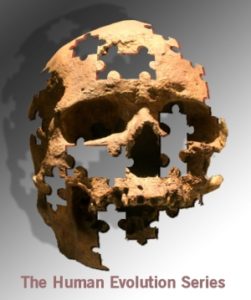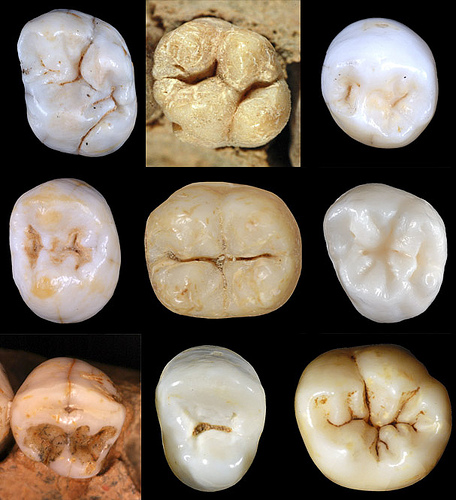
It appears that the search for and identification of fossil remnants of the last common ancestor (termed ‘LCA’ by paleoanthropologists) of both Neanderthals and modern humans, long a subject of debate among scientists studying human evolution, will remain a mystery. At least for now.
So suggests the conclusions of a PNAS-published study conducted by Aida Gómez-Robles, lead author of the paper and a postdoctoral scientist at the Center for the Advanced Study of Hominid Paleobiology of The George Washington University, and an international team of colleagues.
The study, the first of its kind, used quantitative data collection and analysis techniques to reconstruct a mathematically-informed model of the probable dentition of the Neanderthal/modern human LCA. They then compared known fossil dentitions of classified species of Homo (the genus of great apes that includes modern humans and species closely related to them) to the reconstructed LCA model. Fossil examples from the European Middle Pleistocene (ca. 781 to 126 thousand years ago) and others from Africa were used in the comparison. They included fossils of approximately 1,200 molars and premolars from 13 species of Homo, including fossils from the well-known Atapuerca sites in Spain, which have yielded some of the earliest known fossils of ancient humans in Europe. They considered two alternative Neanderthal/modern human divergence times based on previous research: 450 ka (thousand years) based on molecular clock estimate research results; and 1 Ma (million years) based on the morphological (physical form and structure) affinities among the various subject species found in the fossil record.
What they found was that “no known hominin species matches the expected morphology of this common ancestor”.*
“Furthermore,” write Gómez-Robles in their report, “we found that European representatives of potential ancestral species have had affinities with Neanderthals for almost 1 My (million years), thus supporting a model of early divergence between Neanderthals and modern humans.”*
This is a significant finding because Neanderthals and modern humans have previously been thought to have diverged from each other about 300,000 – 700,000 years ago (molecular clock estimate of 450 ka falling within that range) based on genetic studies. Thus the divergence time suggested by the fossil record may possibly be closer to the actual divergence time.
But this early divergence is by no means conclusive.
“Our results call attention to the strong discrepancies between molecular and paleontological estimates of the divergence time between Neanderthals and modern humans,” said Gómez-Robles. “These discrepancies cannot be simply ignored, but they have to be somehow reconciled.”
________________________________________________________________________________________________________
This image shows diversity in premolar and molar morphology in Neanderthals, modern humans and potential ancestral species. Credit: Aida Gómez-Robles, PNAS
_______________________________________________________________________________________________________
Moreover, their research results show that African fossils dated within the range of 500 ka to 1 Ma “merit continued study and are currently the most promising source of candidates for the [Neanderthal/modern human] LCA.”*
But the relevant fossil record in Africa is currently too thin to be used as a viable database.
“The study tells us that there are still new hominin finds waiting to be made,” says P. David Polly, professor in the Department of Geological Sciences in the IU Bloomington College of Arts and Sciences and co-author of the study.
For going forward, the researchers suggest that quantitative and statistical methods provide a better way to settle debates about human origins than the descriptive analyses that have been used in the past. “Our primary aim,” they write, “is to put questions about human evolution into a testable, quantitative framework and to offer an objective means to sort out apparently unsolvable debates about hominin phylogeny.”* They also suggest applying their methodology to study other body parts represented in the hominin fossil record.
The details of the study report can be reviewed in the PNAS (Proceedings of the National Academy of Sciences).
_______________________
*Aida Gomez-Robles, et al., No known hominin species matches the expected dental morphology of the last common ancestor of Neanderthals and modern humans, www.pnas.org/cgi/doi/10.1073/pnas.1302653110.
Source: Aida Gomez-Robles, et al., No known hominin species matches the expected dental morphology of the last common ancestor of Neanderthals and modern humans, and press release of the George Washington University.
________________________________________________________________________________________________________
Read about the most fascinating discoveries with a premium subscription to Popular Archaeology Magazine. Find out what Popular Archaeology Magazine is all about. AND MORE:
 Popular Archaeology’s annual Discovery edition is a selection of the best stories published in Popular Archaeology Magazine in past issues, with an emphasis on some of the most significant, groundbreaking, or fascinating discoveries in the fields of archaeology and paleoanthropology and related fields. At least some of the articles have been updated or revised specifically for the Discovery edition. We can confidently say that there is no other single issue of an archaeology-related magazine, paper print or online, that contains as much major feature article content as this one. The latest issue, volume 2, has just been released. Go to the Discovery edition page for more information.
Popular Archaeology’s annual Discovery edition is a selection of the best stories published in Popular Archaeology Magazine in past issues, with an emphasis on some of the most significant, groundbreaking, or fascinating discoveries in the fields of archaeology and paleoanthropology and related fields. At least some of the articles have been updated or revised specifically for the Discovery edition. We can confidently say that there is no other single issue of an archaeology-related magazine, paper print or online, that contains as much major feature article content as this one. The latest issue, volume 2, has just been released. Go to the Discovery edition page for more information.
Subscription Price: A very affordable $5.75 for those who are not already premium subscribers of Popular Archaeology Magazine (It is FREE for premium subscribers to Popular Archaeology). Premium subscribers should email [email protected] and request the special coupon code. Or, for the e-Book version, it can be purchased for only $3.99 at Amazon.com.






